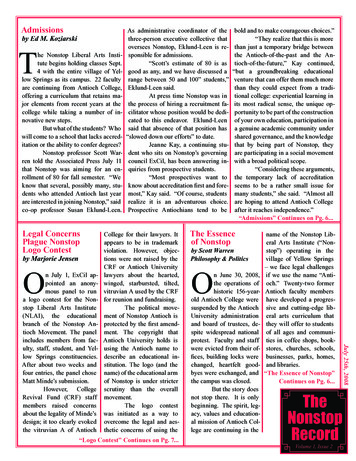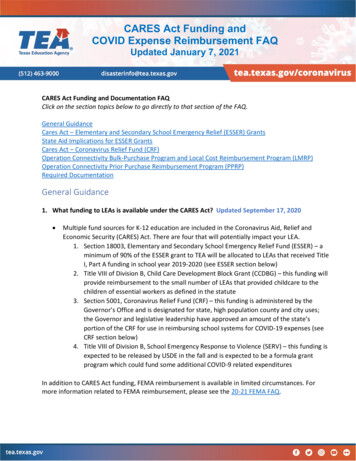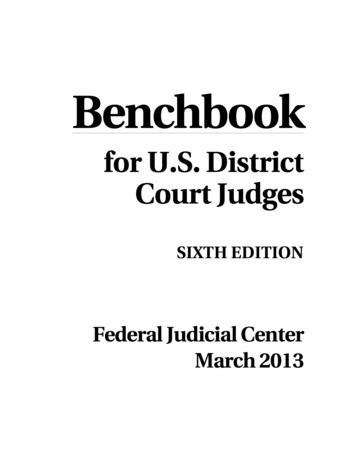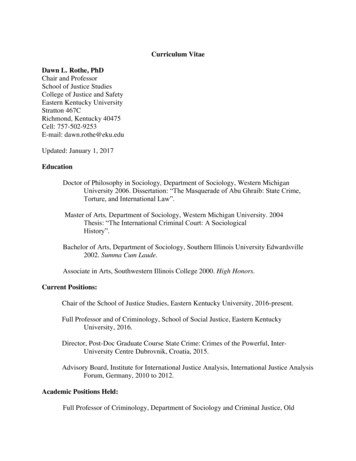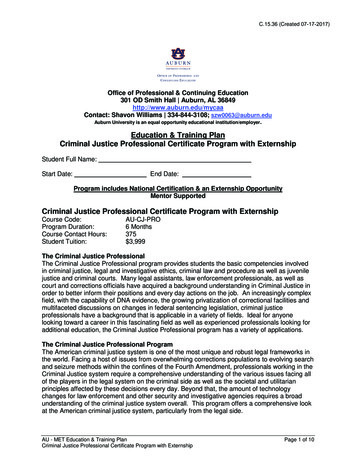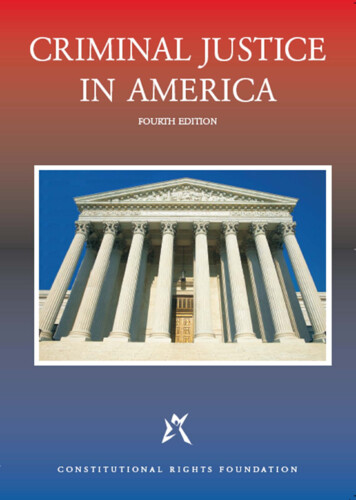
Transcription
(c) Constitutional Rights Foundationwww.crf-usa.orgCRIMINAL JUSTICEIN AMERICAF O U RT H E D I T I O NDeveloped byMarshall CroddyBill HayesTodd Clark
(c) Constitutional Rights Foundationwww.crf-usa.orgCRIMINAL JUSTICE IN AMERICADetailed Table of ContentsINTRODUCTION . . . . . . . . . . . . . 6UNIT 1: CRIME . . . . . . . . . . . . . . 9Chapter 1: CrimesThe Basics of Crime . . . . . . . . . . . . . . . 10Elements of a Crime . . . . . . . . . . . . . . . 11Murder Most Foul. . . . . . . . . . . . . . . . . 13No Honor Among Thieves . . . . . . . . . . 16Hate Crimes . . . . . . . . . . . . . . . . . . . . . 18Cybercrime . . . . . . . . . . . . . . . . . . . . . . 23Chapter 2: DefensesAn Overview of Defenses . . . . . . . . . . . 26Self-Defense. . . . . . . . . . . . . . . . . . . . . . 29The Insanity Defense. . . . . . . . . . . . . . . 31Entrapment. . . . . . . . . . . . . . . . . . . . . . 34Chapter 3: CriminalsHistory of Violent Crime in America . 36How Much Crime Is There? . . . . . . . . . 41Youth, Gangs, and Violence . . . . . . . . . 43White-Collar Criminals. . . . . . . . . . . . . 50Swindlers and Con Artists . . . . . . . . . . 53Chapter 4: Crime VictimsWho Are the Victims?. . . . . . . . . . . . . . 56Victims of Violent Crimes . . . . . . . . . . 56Victims of Property Crimes . . . . . . . . . 59Helping Victims of Crime. . . . . . . . . . . 61The Push for Victims’ Rights . . . . . . . 64UNIT 2: THE POLICE . . . . . . . . . 67Chapter 5: Police and SocietyFrom Volunteers to ProfessionalPolice . . . . . . . . . . . . . . . . . . . . . . . . 68Local Police . . . . . . . . . . . . . . . . . . . . . 70Chapter 6: Methods and InvestigationsCommunity Policing. . . . . . . . . . . . . . . 76Criminal Investigations. . . . . . . . . . . . . 79Crime Labs . . . . . . . . . . . . . . . . . . . . . . 82Chapter 7: Police and the LawCriminal Procedure. . . . . . . . . . . . . . . . 86The Law of Search and Seizure . . . . . . . 87Has a Search or Seizure Taken Place? . . 87Is the Search or Seizure Reasonable? . . 90Motor Vehicle Exception . . . . . . . . . . . 93The Stop and Frisk Exception . . . . . . . 94Other Exceptions . . . . . . . . . . . . . . . . . 98Interrogation and Confessions . . . . . . 102Miranda’s Aftermath . . . . . . . . . . . . . . 104The Exclusionary Rule . . . . . . . . . . . . 109Chapter 8: The Limits of Police AuthorityRacial Profiling . . . . . . . . . . . . . . . . . . 113Police Corruption . . . . . . . . . . . . . . . . 116Use of Force. . . . . . . . . . . . . . . . . . . . . 119Policing the Police. . . . . . . . . . . . . . . . 123You and the Police. . . . . . . . . . . . . . . . 129UNIT 3: THE CRIMINAL CASE . 131Chapter 9: Courts and the Case ProcessThe Two Systems of Criminal Courts . 132Judges and Judicial Independence . . . . 133Criminal Lawyers . . . . . . . . . . . . . . . . . 135The Rights of Criminal Defendants . . 138The Criminal Case Process . . . . . . . . . 143Using This Unit . . . . . . . . . . . . . . . . . 146Chapter 10: Investigation and ArrestArrest . . . . . . . . . . . . . . . . . . . . . . . . . . 148Police Crime Investigation Report. . . . 148State Criminal Code . . . . . . . . . . . . . . 150In the Defense of Thomas Evans . . . . 151Chapter 11: PretrialFirst Appearance Before a Judge . . . . . 153The Question of Bail . . . . . . . . . . . . . 153Prosecutorial Review . . . . . . . . . . . . . . 155Plea Bargaining . . . . . . . . . . . . . . . . . . 159Probable Cause Hearing. . . . . . . . . . . . 161Evans’ Probable Cause Hearing . . . . . . 162Arraignment . . . . . . . . . . . . . . . . . . . . 162An Issue at the Arraignment . . . . . . . . 163
(c) Constitutional Rights Foundationwww.crf-usa.orgChapter 12: TrialTrial Procedures . . . . . . . . . . . . . . . . . . 165Cast of Characters . . . . . . . . . . . . . . . . 166The Trial of Thomas Evans . . . . . . . . . 168Jury Selection. . . . . . . . . . . . . . . . . . . . 169Trial Strategy . . . . . . . . . . . . . . . . . . . . 173Opening Statements. . . . . . . . . . . . . . . 174Direct and Circumstantial Evidence . . 175Rules of Evidence . . . . . . . . . . . . . . . . 177Closing Statements . . . . . . . . . . . . . . . 186Instructing the Jury . . . . . . . . . . . . . . . 187UNIT 4: CORRECTIONS . . . . . . 191Chapter 13: Corrections and SocietyThe Purpose of Punishment . . . . . . . . 192A Brief History of Punishment. . . . . . 193Sentencing . . . . . . . . . . . . . . . . . . . . . . 196Chapter 14: Current DebatesThe Shaky Status of SentencingGuidelines . . . . . . . . . . . . . . . . . . . . . 203Are Too Many People Behind Bars? . . 206Do Sentences Have to BeProportionate? . . . . . . . . . . . . . . . . . . 210Crack Versus Cocaine . . . . . . . . . . . . . 213Chapter 15: Alternatives to PrisonThe Need for Alternatives . . . . . . . . . . 217Fines. . . . . . . . . . . . . . . . . . . . . . . . . . . 217Probation . . . . . . . . . . . . . . . . . . . . . . . 218Revoking Probation. . . . . . . . . . . . . . . 221Community Service . . . . . . . . . . . . . . 225Community Corrections. . . . . . . . . . . 226Chapter 16: Prisons TodayPrison in America . . . . . . . . . . . . . . . . 230Prison Revolts . . . . . . . . . . . . . . . . . . . 235Parole. . . . . . . . . . . . . . . . . . . . . . . . . . 238Staying Out of Prison . . . . . . . . . . . . . 241Chapter 17: Capital PunishmentHistory of the Death Penalty . . . . . . . 242Public Opinion on theDeath Penalty . . . . . . . . . . . . . . . . . 248Recent Developments . . . . . . . . . . . . . 249UNIT 5: JUVENILE JUSTICE . . . 255Chapter 18: From Criminal to DelinquentChildren and the Law: A History . . . . 256From Criminal to Delinquent . . . . . . 258Different Worlds: The Two Systems . . 262Chapter 19: The Problem of DelinquencyWhat Is Delinquency?. . . . . . . . . . . . . 264A Tour of the System . . . . . . . . . . . . . 265Initial Detention of Juveniles . . . . . . . 267Chapter 20: Children & the ConstitutionThe Rights of Juveniles . . . . . . . . . . . . 272School Searches . . . . . . . . . . . . . . . . . . 279Chapter 21: Juvenile CorrectionsOptions for Placing JuvenileOffenders . . . . . . . . . . . . . . . . . . . . 284Problems With Locking Up Juveniles . 288At Home Plus . . . . . . . . . . . . . . . . . . . 289The Question of Waiver . . . . . . . . . . . 291Simmons and the Death Penalty . . . . 294Roper v. Simmons (2005) . . . . . . . . . . . . 295Current Trends and Controversies . . . 296UNIT 6: SOLUTIONS . . . . . . . . 299Chapter 22: The Causes of CrimeTheories and Approaches . . . . . . . . . . 300Social and Cultural Factors . . . . . . . . 300Individual and Situational Factors . . . 303Chapter 23: Crime and the GovernmentThe Role of Government . . . . . . . . . . 307Crime and the Federal Government . . 307Federal Policy: The Patriot Act . . . . . . 309Federal Policy: Gun Control . . . . . . . . 313An Attack on Crime: State Level . . . . . 316New Role of State Supreme Courts . . . 321The Color of Justice . . . . . . . . . . . . . . 322Chapter 24: Crime and the CitizenGetting Involved in Fighting Crime . . 328Vigilantes in American History . . . . . 328Crime in Schools. . . . . . . . . . . . . . . . . 332Burglary Prevention. . . . . . . . . . . . . . . 336A Conclusion on Crime . . . . . . . . . . . 344APPENDIXExcerpts From the U.S. Constitution . 347Glossary. . . . . . . . . . . . . . . . . . . . . . . . 350Table of Cases . . . . . . . . . . . . . . . . . . . 356Index . . . . . . . . . . . . . . . . . . . . . . . . . . 358Credits . . . . . . . . . . . . . . . . . . . . . . . . . 360
(c) Constitutional Rights Foundationwww.crf-usa.orgCHAPTER 17Capital PunishmentHistory of the DeathPenalty in America“Capital punishment” is another expression for the death penalty, or the legal execution of a criminal. The word capital comesfrom the Latin word for head. In ancienttimes, capital punishment was often carriedout by beheading. This method has neverbeen used in America. But criminals havebeen put to death by shooting, hanging, electrocution, poison gas, and lethal injection.Today, the most common method is lethalinjection, followed by electrocution. Somestates, however allow one of these other methods as an option.Once a person is sentenced to death inAmerica, most states follow a similar procedure. The sentenced criminal is normally heldin a maximum-security prison’s special section known as death row. Usually, prisonerson death row have little contact with otherprisoners. Each occupies a small cell alone,and each takes meals and exercises alone. Thislife may continue for years during appeals ofthe sentence. An appeal hearing for a deathsentence is automatic in every state exceptArkansas.In the American colonies legal executionstook place as early as 1630. As in England, thedeath penalty was imposed for many differentcrimes, even minor ones such as pickingpockets or stealing a loaf of bread. During the1800s in England, for example, 270 differentcrimes were capital offenses, or crimes punishable by death. Thousands of people sometimes attended public hangings. Gradually,however, England and America reduced thenumber of capital offenses, until the mainfocus was on first-degree murder—murdersshowing deliberation, willfulness, and premeditation. They also moved executions with242CRIMINAL JUSTICE IN AMERICAin the walls of prisons to eliminate the spectacle of public executions.In the 1800s, many people in Americaand Europe began to oppose the death penalty altogether. Michigan abolished it in 1845and Wisconsin entered the Union in 1848without a death penalty in its statutes. Themovement against the death penalty grewstronger after World War II, especially inEurope, where many were weary of so muchkilling during the war. One by one all theWestern European nations and Canada didaway with capital punishment, until theUnited States was the last Western democracythat still executed criminals. Twelve Americanstates, mainly clustered in the Midwest andNortheast, have also banned executions. NewYork, which had banned the death penalty 30years before, reinstated it in 1995.Public opinion on the death penalty hasvaried over time. In the 1930s, opinion pollsshowed strong support for capital punishment. From that time, support graduallydeclined. By the mid- 1960s, it had fallen toless than 50 percent. But then support startedto rise again. By the 1990s, following decadesof widespread anxiety over crime and violence, some states such as California wereshowing almost 80 percent of the populationin favor of executing criminals. Other pollsshowed that 62 percent of the population feltthat the death penalty deterred crime, and 51percent said they would support it even if itdid not deter crime.In 1991, researcher Robert M. Bohm didan analysis of 21 different polls on the deathpenalty. He found that certain factors—people’s religion, age, occupation, or size of thecity they lived in—showed little relation totheir attitude on capital punishment. Butother factors did. Men were more likely tofavor it than women. Whites supported it
(c) Constitutional Rights Foundationwww.crf-usa.orgNumber of Persons Executed in the United States, 1930–2004250Number of 2004Source: “Key Facts at a Glance,” Bureau of Justice Statistics (2005)more than blacks. Republicans endorsed itmore than Democrats. The wealthy approvedit more than the poor. People from the Southwere more likely to oppose the death penaltythan people from other regions.Recent Legal History of the DeathPenaltyFollowing public protest over capital punishment in the 1950s and 1960s, the numberof executions in America gradually declined.In 1967, there were only two, and the followingyear the Supreme Court struck down deathpenalty laws for crimes other than murder—crimes such as kidnapping, rape, and federalbank robbery. That year also saw the beginning of an unofficial moratorium on executions. States waited to see how the SupremeCourt would rule on the constitutionality ofcapital punishment. No executions took placein the United States from 1968 through 1976.In the 1972 case of Furman v. Georgia, theSupreme Court declared capital punishmentunconstitutional as it was then applied. Thecourt said the death penalty was a violation ofthe Eighth Amendment prohibition againstcruel and unusual punishment because theredid not seem to be any consistency in whowas given a death sentence and who was not.The court suggested that new laws might beacceptable, if they provided clear standardsfor which criminals should be given deathsentences.Between 1972 and 1976, 35 states wrotenew capital punishment laws to try to meetthe Supreme Court’s suggestions. These newlaws fell into two broad groups. One group,represented by laws in Georgia, Texas, andFlorida, clearly described which capital crimescould be punished by death. These laws alsoset up a weighing system for deciding whenthe death penalty should be applied. In a separate penalty trial after a conviction for firstdegree murder, a jury would consider mitigating circumstances that tended to excusethe crime or the criminal’s behavior andaggravating circumstances that made thecrime seem worse. The court could only sentence someone to death if the aggravating circumstances outweighed any mitigating circumstances.A second group of laws, represented bystatutes from North Carolina and Louisiana,Unit 4: Corrections243
(c) Constitutional Rights Foundationwww.crf-usa.orgsought to overcome the Supreme Court’sobjections in another way. These laws simplymade the death penalty mandatory for anyone convicted of a capital crime.In 1976, the Supreme Court in Gregg v.Georgia ruled that the first type of law, basedon the act of balancing mitigating and aggravating circumstances, was constitutional. Thisupheld the Georgia, Texas, and Florida deathpenalties. The court, however, struck downthe second type. It declared unconstitutionalNorth Carolina’s and Louisiana’s mandatorydeath sentences. The court said a mandatorysentence was unduly harsh and rigid andmade no allowance for the particular circumstances of each case.Executions began again in 1977, thoughmany states still waited for a ruling on onefurther major issue: whether the death penalty was being applied equally. From 1977through 1985, only 50 executions took place,though almost 2,000 prisoners waited ondeath rows.The test case came with the Georgia caseof McCleskey v. Kemp (1987). In it, lawyers forthe condemned man submitted a study ofhow the death penalty had been applied inGeorgia during the 1970s.The study, by University of Iowa ProfessorDavid Baldus, showed that blacks who hadkilled whites had been sentenced to die seventimes more often than whites who had killedblacks. Even after accounting for other variables, such as the viciousness of the crime,blacks had been sentenced to die more thanfour times as often as whites.In its decision, the U.S. Supreme Courtacknowledged that there seemed to be somestatistical racial discrimination in Georgia’sapplication of the death penalty. But the justices ruled by a 5–4 vote that a mere statisticalvariation was not enough to invalidate thedeath penalty. To do that, the defendantwould have to show that the state had somehow encouraged the result or that there wasactual discrimination in a particular case.Since the defendant had offered no suchproof, which would be difficult to acquire,the court upheld the death penalty.244CRIMINAL JUSTICE IN AMERICAIn the decade after McCleskey, the courttended to support the prosecution and makeappeal of a death sentence more difficult. Thejustices ruled that: Death-row inmates have no right to freelegal assistance after an initial round ofappeals. (Murray v. Giarratano, 1989) Inmates may lose their right to appeal ifthey make procedural errors. (Coleman v.Thompson, 1991) Inmates can’t take advantage of any rulechanges or precedents set after they haveexhausted their appeals. (Teague v. Lane,1989; Butler v. McKellar, 1990; and Saffle v.Parks, 1990) The prosecution may introduce victimimpact statements in penalty hearings.These statements may detail the pain andsuffering of the victim. This decision overturned several earlier rulings banning suchstatements because they tend to inflamejuries against convicted murderers. (Paynev. Tennessee, 1991) Death-row inmates cannot get a federalhearing on new-found evidence provingtheir innocence unless that evidence overwhelmingly proves their innocence.(Herrera v. Collins, 1993)In 1996, Congress passed the AntiTerrorism and Effective Death Penalty Act.Part of this act limited state prisoners’ habeascorpus appeals in federal court. The writ ofhabeas corpus is guaranteed by the U.S.Constitution. The writ is an order to bring aprisoner before a court to determine if theprisoner is legally held. Many death penaltyappeals are petitions of habeas corpus.Supporters of the act say many prisoners aresimply buying time by filing frivolous habeascorpus petitions. Opponents of the lawargued that capital cases should be carefullyreviewed and that the act prevents this. InFelker v. Turpin in 1996, the Supreme Courtupheld this part of the act.But beginning in 2000, the SupremeCourt decided a series of cases that upheldprisoners’ rights to appeal and limited thedeath penalty. In 2000, it overturned two
(c) Constitutional Rights Foundationwww.crf-usa.orgPersons Under Sentence of Death, 1953–2003350025002000In 1972, the Supreme Courtruled unconstitutional the deathpenalty as then administered.Number of Persons3000In 1976, the court upheld revisedstate capital punishment laws.15001000500200319831973196319530YearSource: “Capital Punishment 2003,” Bureau of Justice Statistics (2004)federal court decisions that had rejected statehabeas corpus appeals because of the 1996 act.The Supreme Court said that the 1996 actonly banned unreasonable appeals. When“clearly established” constitutional rightshave been violated, the federal courts mayintervene. The two Virginia cases involveddefendants with the same last name, but thedefendants were not related.In Terry Williams v. Taylor, the court ruled6–3 that the defendant had been deprived ofhis right to effective counsel. The defenseattorney failed to mention at the sentencinghearing that the defendant was borderlinementally retarded, he had been fed whiskey asa child, and his parents had been jailed forchild abuse and neglect.In Michael Wayne Williams v. Taylor, a unanimous court ruled that the defendant did notreceive a fair trial. The jury forewoman failed todisclose that she was the ex-wife of the sheriffand a former client of the prosecutor.In 1989, the Supreme Court had ruled thatmentally retarded criminals could be executed(Penry v. Lynaugh). In 2002, the court over-ruled this opinion in the case of Atkins v.Virginia. In a 6–3 decision, the court declaredthat it was cruel and unusual punishment toexecute the mentally retarded. The courtnoted that since its decision in Penry, thenumber of states outlawing such executionshad grown from two to 18 and that in otherstates the practice was rare. The court majority found that a consensus had grown in theUnited States against executing mentallyretarded persons.In 2005 in Roper v. Simmons, the SupremeCourt overruled a previous decision on executing murderers who were under 18 whencommitting the crime. The court declaredsuch executions violated the EighthAmendment. The 5–4 court majority pointedout that only two nations in the worldallowed such executions—the United Statesand Somalia. It also noted that although 19states permitted these executions, only threestates had carried them out in the last decade.In recent years, about 60 prisoners havebeen executed each year. More than 3,000inmates wait on death rows in prisons acrossUnit 4: Corrections245
(c) Constitutional Rights Foundationwww.crf-usa.orgAmerica. Much of this backlog is caused byappeals. Even though some rulings have madeit harder to appeal, it still takes an average ofnine years for each prisoner to exhaust theappeals process. And it costs a state from 2to 3 million to process each case.Two studies by a Columbia Law Schoolprofessor, published in 2000 and 2002, foundthat most death-row appeals succeed.Surveying the almost 5,000 capital casesappealed in state and federal courts between1973 and 1995, the first study revealed thatappeals courts found errors serious enough tooverturn convictions in almost 70 percent ofthe cases. Three-fourths of those with overturned convictions got a sentence less thandeath when the case was retried or plea bargained. The second study found: “The higherthe rate at which a state or county imposesdeath verdicts, the greater the probability thateach death verdict will have to be reversedbecause of serious error.”Opponents of the death penalty arguethat these statistics expose a deeply flawed system. Supporters of the death penalty counterthat the studies reveal how carefully the system reviews each case to make sure only thosedeserving the death penalty receive it.For Discussion1. Why do you think prisons separate thosesentenced to death from other prisoners?2. Why do you think the United States is theonly Western democracy that executescriminals?3. What reason did the Supreme Court givein Furman for saying that death penaltystatutes were unconstitutional? How didstates change their statutes to make themconstitutional? Do you agree with thecourt that these statutes are constitutional?Why or why not?4. What did the court decide in the McCleskeycase? Do you agree with its decision? Whyor why not?5. Which of the decisions after McCleskey doyou agree with? Disagree with? Why?6. Some have argued that executions shouldbe televised. Do you agree? Explain.246CRIMINAL JUSTICE IN AMERICAClass Activity: Life or DeathIn this activity, students role play sentencing juries in capital cases using a capital punishment statute. The defendant in each casehas already been convicted of first-degreemurder. Each jury must determine the penalty. The only two choices available are lifeimprisonment or death.1. Form four juries. Review the CapitalPunishment Statute, below. Each juryshould decide one of the four cases onpage 247.2. Members of each jury should:a. Make a list of the mitigating circumstances, those that seem to call formercy.b. Make a list of the aggravating circumstances, or those that make the crimeseem especially violent or repulsive.c. Weigh the mitigating and the aggravating circumstances against each other. Ifthe jury feels the case calls for leniency,it should recommend life imprisonment. If it thinks the case is particularly barbarous or savage, it should recommend death. The recommendationdoes not have to be unanimous. Onlya majority is required for a sentencingrecommendation.d. Prepare to report to the class. Onestudent in each group should reportthe mitigating circumstances thegroup considered. Another studentshould report the aggravating circumstances. A third student shouldreport the sentence and the numberof students who voted each way.Capital Punishment Statute. After finding adefendant guilty of murder in the first degree,the jury shall look at the circumstances of thecrime and at the character of the individualdefendant. If it finds the aggravating circumstances of the crime and the defendant outweigh the mitigating circumstances, it shallreturn a recommendation of the deathpenalty. Otherwise, it shall recommend lifeimprisonment.
(c) Constitutional Rights Foundationwww.crf-usa.orgCase 1: Luby WaxtonAge: 22Sex: MaleLuby has been in and out of jail ever sincehe was a teenager. He was convicted ofshoplifting, burglary, and assault with a deadly weapon. He received a light sentence foreach, because he has the mental capacity of an8 year old.On June 3 of this year, Waxton begandrinking in the morning. He decided to rob alocal grocery store to get some money. Thatafternoon, Waxton bought a small handgun.When he got to the market, he entered thestore, bought some cigarettes, and thenannounced a holdup.Waxton went behind the counter andemptied the cash register. He put his gun tothe sales clerk’s head and pulled the trigger.The clerk, an old woman, died instantly.Waxton was convicted of armed robberyand murder in the first degree.Case 2: James WoodsonAge: 24Sex: MaleWoodson has no prior record of beingarrested.Woodson has been active in the anti-abortion movement. He believes that abortion ismurder. After taking part in picketing anabortion clinic, Woodson became frustratedthat the clinic remained open. He believedthat much stronger action was necessary, butknew his fellow picketers would not go alongwith him.So late on the night of July 17, he brokeinto the clinic. He poured gasoline throughout the first floor and put a match to it. Theclinic burned to the ground. Unknown toWoodson, a security guard was on the thirdfloor. The guard died in the fire.Woodson was convicted of arson andfirst-degree murder.Case 3: Phong TranAge: 18Sex: MaleTran has a series of prior juvenile arrestsfor petty theft and assault. He has beeninvolved in gang activity for the past fiveyears.His family immigrated to the UnitedStates when he was 7 years old. His fatherabandoned the family shortly afterward, andhis mother could not handle three childrenby herself. Placed in a foster home at age 13,he ran away and took to the streets.He found a new family in a local gang,headed by Tony Chin, age 35. Chin providedboys in the gang free housing, meals, movies,and video games. In return, they ran errands,protected Chin’s businesses, and helpedChin’s criminal enterprises. Tran looked onChin as his father.On January 7 of this year, Chin handedTran a gun and told him that a “customer”needed a new Mercedes. Tran went to a minimall and waited in the parking lot. WhenSally Kim drove up in a new Mercedes, Tranran up, pointed a gun at her, and demandedshe get out. The car lurched and Tran shotKim, killing her.Phong Tran was convicted of first-degreemurder.Case 4: Sonia WilliamsAge: 27Sex: FemaleWilliams has no prior record.On September 10 of this year, Williamscalled the police and reported that she hadbeen raped by a man named Greg. She wastaken down to a hospital where a doctorexamined her. He said he could find no evidence of rape.The police investigated her report andtold Williams they could not arrest Greg. Itwas dark, they said, so she could have beenmistaken about the identity of the attacker.Besides, they said, Greg had a perfect alibi forthe night in question.Williams decided to take matters into herown hands. She bought a gun and waitedaround the corner where he allegedly firstUnit 4: Corrections247
(c) Constitutional Rights Foundationwww.crf-usa.orgattacked her. When Greg and a friendapproached, she told Greg she had been looking for him and was glad to see him. Sheinvited the two men to go somewhere for adrink. They got into her car and drove to asecluded spot, where she shot and killed bothmen.Sonia Williams was convicted of firstdegree murder.Debriefing Questions1. Do you think different juries would weighthe aggravating and mitigating circumstances differently? If so, is this fair? Whyor why not?2. If you were called to jury duty in a capitalcase, could you vote for the death penaltyif circumstances warranted it? Why or whynot?3. Assume for the moment that you approveof the death penalty, what crimes should itapply to? Why?248CRIMINAL JUSTICE IN AMERICAPublic Opinion on theDeath PenaltyThe public’s attitude toward capital punishment has changed over the years. Pollsshow that the American public today strongly supports the death penalty. This supporthas grown much stronger since the 1960s. Butpolls also show that the strength of this support depends on how you ask the question.Note the differences between the two questions asked by Gallup polls.Are you in favor of the death penalty for aperson convicted of murder?ForAgainst No 337
(c) Constitutional Rights Foundationwww.crf-usa.orgWhat do you think should be the penaltyfor murder: the death penalty or lifeimprisonment with absolutely no possibility of parole?DeathLifeNoPenalty Imprisonment 03713199153351119865535101985563410For Discussion1. What do you think accounts for the shiftin public opinion favoring the deathpenalty?2. What do you think accounts for the different responses to the two questions? Whichquestion do you think is better? Why?Activity: Death Penalty PollIn this activity, students conduct a pollon the death penalty.1. Decide who you are going to poll. It canbe the community, the school, or just onegrade level.2. Decide on how to get a random sample ofthe group you are polling. Determine howlarge a sample you will take.3. Divide the class in two. One group shouldask the first question; the other group, thesecond question.4. Tabulate the results.Debriefing Questions1. How do your results compare with theofficial poll results?2. How do you account for the similarities ordifferences?Recent Developments inCapital PunishmentAs of 2003, more than 3,000 prisoners wereon death rows in the United States. Californiaheld the most (629), followed by Texas (453),Florida (364), and Pennsylvania (230). Despitethese numbers, only about 60 convicts are executed each year. Part of this can be explained bythe long appeals process. But there also appearsto be a social reluctance to begin executing massive numbers of prisoners. Between 1977 and2003, about 900 executions took place, most ofthem in the South. In fact, seven Southern statescarried out three-fourths of all executions. Thestate of Texas by itself accounted for one-thirdof them.Most of the executions ha
242 CRIMINAL JUSTICE IN AMERICA History of the Death Penalty in America "Capital punishment" is another expres-sion for the death penalty, or the legal execu-tion of a criminal. The word capital comes from the Latin word for head. In ancient times, capital punishment was often carried out by beheading. This method has never been used in .

